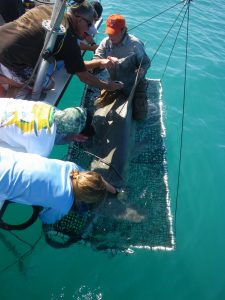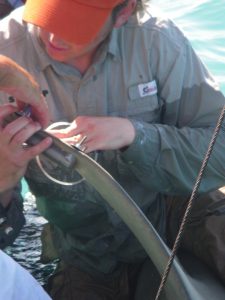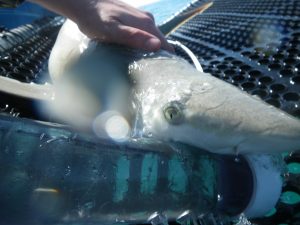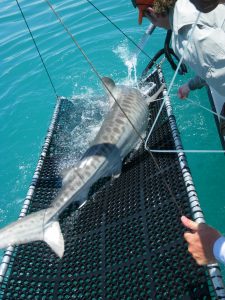A new site for shark research!
Shark Trip May 25, 2010
Our shark team has a joint collaborative project between UM RJ Dunlap Marine Conservation Program, The West Coast Inland Navigational
District (WCIND) and Florida Gulf Coast University (FGCU), supported by Commissioner Ray Judah of Lee County. The primary area of research will in the southern waters of Lee County where ongoing nutrient cycling projects are being conducted by FGCU. The goals of this collaboration include: (1) Determine range and territorial waters of sharks; (2) obtaining tissue samples for analysis of methyl-mercury and red tide toxin for risk-assessment studies; and (3) examine the stable isotope analyses of sharks to investigate trophic dynamics in marine ecosystems.
This area is also known for its large shark inhabitants, so we were hoping to deploy more satellite tags to increase our sample size and range of shark tagged and compare these results to previous tagging in the Florida Keys. Also joining us on our first sampling trip in the new area were videographers Mark Rackley and Christian Gatti, both loaded with film to capture as much footage as possible of any sharks we caught for educational purposes. Which they did!

The Shark Team is putting a satellite tag on a 11.9 ft Great Hammerhead in record time. The animal swam away in great condition. Great job guys! (click to enlarge).
It is always a little nerve-wracking trying out a new site, but hopes were high as we cruised out to our newest shark sampling site. We reached the site quickly, and put our first 10 drumlines in the water. We then anxiously watched the clock until our 1.5 hour soak time was completed, allowing us to check our lines. The first 3 lines came up empty, and we started to wonder if we had assessed the area accurately when we picked our site. Luckily on the fourth drumline we were rewarded with a small female blacktip shark (4 ft in length). The energy level on the boat started to rise after catching our first shark of the day, and we looked forward to pulling up the rest of our lines to see what else was waiting on the hooks.
Unfortunately we hit another dry spell, pulling up 5 empty lines. Just as the crew was starting to get disheartened again, the shark gods came through for us. On our 10th drumline we hooked a beautiful 8.3 ft female tiger shark. The crew was ecstatic. The cameras started rolling as we satellite tagged our first ever tiger shark, which I believe is also the first tiger shark to be SPOT satellite tagged in the Gulf of Mexico. The crew worked quickly to attach the satellite tag to the dorsal fin of the tiger, which was later named Sophi after our youngest shark team member. First grader Sophi is a budding shark conservationist, who has started her own funding campaign to save sharks. She has been working hard in her hometown in Minnesota to raise awareness about the decline in shark populations. Sophi the shark swam away well with her new satellite tag, and we look forward to tracking her on our website soon. Also, don’t forget to keep up the date on human Sophi’s blog to learn more about her efforts to save sharks.
Now the whole boat was pumped and ready to check on our last 5 lines, we were all waiting on pins and needles to see what else we would catch. The shark gods came through for us again because we caught another tiger shark and a huge great hammerhead on the last 5 lines. The second tiger shark was next, a 6.6 ft feisty female that we named Sweet Caroline. She was a tough shark to reel in, even though she was smaller in size than the previous tiger shark. Again the shark crew sprang into action, attaching another satellite tag to the shark with lightning speed, so we could quickly release her back into the water. On the following drumlines, we caught a huge great hammerhead. The great hammerhead was found to be 11.9 ft in length, and was named D-Money after me! She was a beauty and swam away from the boat like a champion. The film crew captured some amazing footage of the hammerhead on the sling as well as swimming away after being satellite tagged.

Dr. Neil Hammerschalg and Captain Curt are making sure the satellite tag is secure before releasing the shark. (click to enlarge).

Matt, a student from Florida Gulf Coast University came out to help us these two days, thank you so much for your hard work! (click to enlarge).
The team set a new record by deploying 3 satellite tags during one day in the field. We had high hopes for the day when we started out early on Tuesday morning, but none of us expected to have such a fantastic day on the water our first time at a new site. After getting back to the boat, and organizing our gear for the next day’s trip we all crowded together around a computer monitor and watched some of the spectacular footage that was taken over the course of the day. We all felt so lucky to have seen 4 beautiful sharks on the water that day, and tried to get to bed early so we would all be fresh for our second day of sampling the following morning.
Cheers,
Dominique Lazarre (Shark Program Coordinator & lab manager)



Leave a Reply
Want to join the discussion?Feel free to contribute!